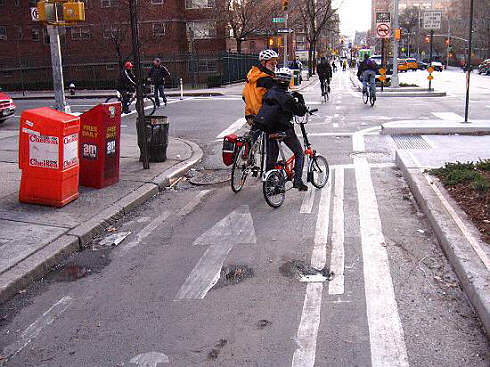Manhattan’s 9th Avenue bikeway, extending from 31st Street to 14th Street, is mostly a signalized left-curbside one-way on-street path, separated over most of its length from mixed-flow travel lanes by an in-street car parking lane. A couple of blocks near the end are separated only by a striped median or a single stripe. The barrier separation is the first of its kind in Manhattan but as is usual with bike lanes on Manhattan’s one-way avenues, the 9th Avenue bikeway on the left side — for two reasons:
a) Buses, which run frequently, use and stop in the rightmost lane of this multi-lane one-way street
b) Truck deliveries and taxi pickups/dropoffs occur in the rightmost lanes
Those activities are impractical on the left side of 9th Avenue on the bikeway blocks because the bikeway is separated from the rest of the Avenue by a left-side in-street parking lane.
To me, this bikeway — on the “parking-separated path” blocks — violated no traffic engineering principles. Its designers made a choice and followed it through in all the details — except perhaps to facilitate a “bike through on vehicle left-arrow” technique which would increase green time for bicyclists. For what it is, the 9th Avenue scheme is very well designed. I can imagine that it would function fairly well for bicyclists even at busier times than we observed.
When discussing pedestrian conflicts affecting such a bikeway, it’s useful to separate mid-block activity from intersection activity. Mid-block, the 9th Avenue bikeway runs beside the in-street parking lane except at the block-ends where there is either a signalized vehicle left turn lane (if the cross street is two-way or one-way-left) or a wide island “capping” the parking lane (if the cross street is one-way-right). The parking lane has a generous left-side door zone buffer with centered flex posts. This enables unhurried access to the left side of parked vehicles, including loading/unloading of cargo and kids, with minimal conflict to bicyclists in the curbside path except when the car-using pedestrians are actually crossing the bikeway. And they can choose relatively safe gaps to cross the bikeway without having to wait long, because the street has short-cycle signals every block, which platoon the bicyclists to some extent.
Pedestrian conflicts at intersections are qualitatively different. Here the conflict level depends on the pedestrian volume on the north (approach) side of each cross street, and the capacity of the left-side corner area to store sufficient numbers of pedestrians during the 90-second signal cycle such that none of them will spill out into the bikeway — especially while bicyclists had the green (bike) signal. On 9th Avenue, this corner ped storage capacity was seldom a problem during our several hours of observation and cycling on a Friday and Saturday. There were more ped-at-cross-street conflicts where the cross street was one-way-right, because on those intersection approaches the area to the right of the curbside bikeway was a wide island that terminated the parking lane. The crosswalk area protected by this in-street island provided a head-start for pedestrians crossing left-to-right, and they would filter across the bikeway at all times in order to reduce their crossing time when the Walk signal came on.
I consider the 9th Avenue bikeway to be “proper” engineering in the small (i.e. purely technical sense) but not in the larger (public stewardship) sense that considers the legal framework that governs a street’s function for all users. Clearly, cyclists must be able legally to access right-side destinations along 9th Avenue, regardless of the intensity of vehicular activity (and [mis-]perceptions of the dangers thereof). If a street is considered as a whole system but the combination of its bikeways and applicable laws denies cyclists legal access to all destinations accessible to motor vehicle users, cyclists’ rights are violated and the situation must be rectified.
To my reading, applicable NYC law lacks a clause clearly establishing the right of cyclists to operate on the opposite side on streets with one-side-segregated bikeways, similar to the California Vehicle Code’s enumeration of exceptions to the Far-To-The-Right (FTR) bike laws (CVC 21202 and 21208). The section might be read to allow right-side operation, but I don’t like depending on lawyers and judges to read between the lines in favor of cyclists. NYC DOT should work to have the applicable section amended or repealed to provide the needed clarity.


Pingback: John S. Allen's Bicycle Blog » Guest posting: John Ciccarelli on the NYC Broadway bikeway
Pingback: John S. Allen's Bicycle Blog » Gridlock Sam’s magic powers!